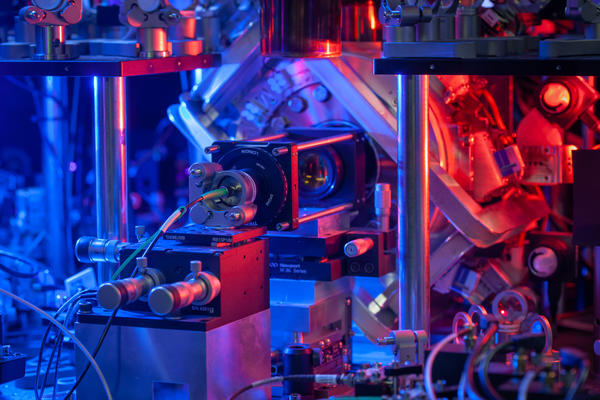Robust Quantum Memory in a Trapped-Ion Quantum Network Node
Research published recently by a team of QCS Hub researchers at the University of Oxford has demonstrated the integration of a quantum memory into a trapped-ion quantum network node, allowing quantum information to be stored for up to 10 s, and preserving the full network capabilities of the node. This breakthrough is an important step forward in building the quantum networks required to develop fully scalable quantum computers.
Trapped-ion quantum computing is a well-developed platform for quantum computation, in which single ions (charged atoms) suspended in a magnetic or electric field are used as qubits (quantum bits) for information processing. The Oxford team are building a network of quantum computers, using trapped ions to store and process quantum information. Their network connects quantum computing devices using single photons emitted from a single atomic ion, using quantum entanglement between this ion and the photons.

Image credit: David Nadlinger, University of Oxford
Different ions offer different benefits in terms of their use in quantum networking, and the team has implemented these in ways that provide varying advantages. Interfacing strontium ions and photons, for example, has allowed the team to generate distributed entanglement between two distant network nodes with an unprecedented combination of speed and quality. This is important in terms of interconnecting different computing nodes. Using calcium ions on the other hand can provide high-fidelity quantum logic and long-lasting quantum memory, enabling quantum information to be processed reliably.
The new technique presented by the researchers in their paper is able to combine these capabilities for the first time, creating high-quality entanglement between a strontium ion and a photon and thereafter storing this entanglement in an adjacent calcium ion. The Oxford team has been able to preserve the information on this memory ion for more than 10 seconds – at least 1,000 times longer than is possible using a strontium ion alone. Furthermore, the strontium ion can be reused to generate further photons without corrupting the memory.
Professor David Lucas, whose colleagues at the University of Oxford have developed these new techniques said “The ability to interconnect quantum computation nodes combined with the capability of processing and storing quantum information with high fidelity is crucial for building scalable quantum computers and for a host of applications in quantum communications. In this experiment we demonstrated one of the most important building blocks in this long-term challenge”.
The demonstration is an important milestone towards distributed quantum information processing. Each quantum computational node can now be loaded with a number of processing (calcium) qubits, while the network qubit (strontium) can be used to create quantum links between distant modules. It is a path towards scalable quantum computing because having small modules capable of processing and interconnecting with other modules circumvents the need for largeand complex ion traps.
The long entanglement storage times achieved in the team's experiments will also have direct applications in private quantum computation and are key for new developments in quantum communications, metrology and timekeeping. For the nascent field of entangled atomic clocks, it will lead to an order-of-magnitude improvement in the precision of frequency comparison between distant clocks.
The paper, “Robust Quantum Memory in a Trapped-Ion Quantum Network Node,” is published in the journal Physical Review Letters: https://journals.aps.org/prl/abstract/10.1103/PhysRevLett.130.090803